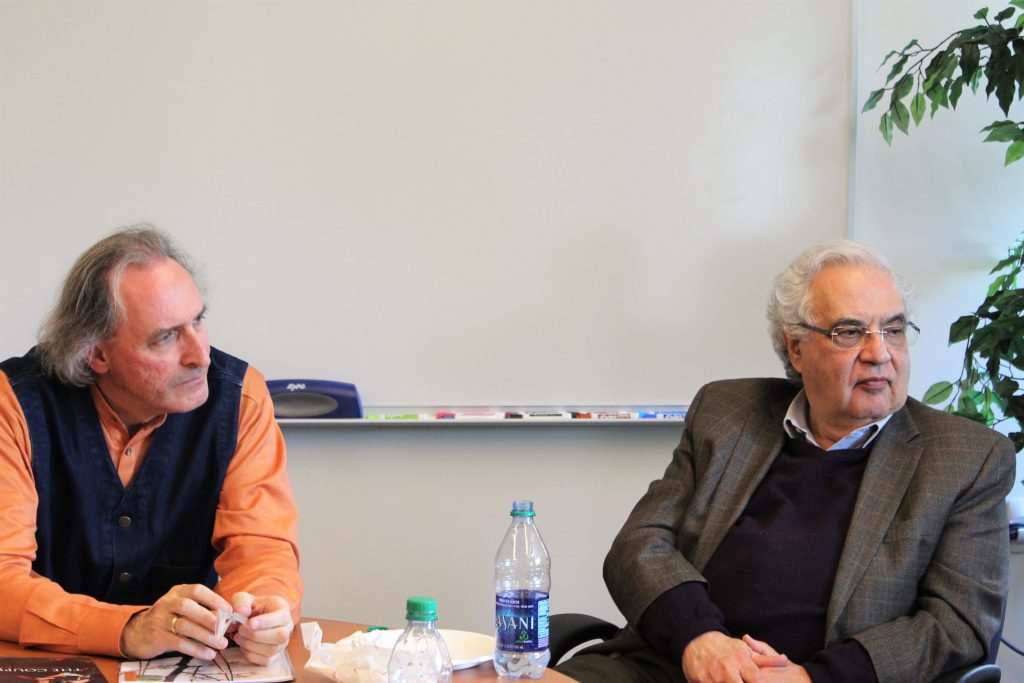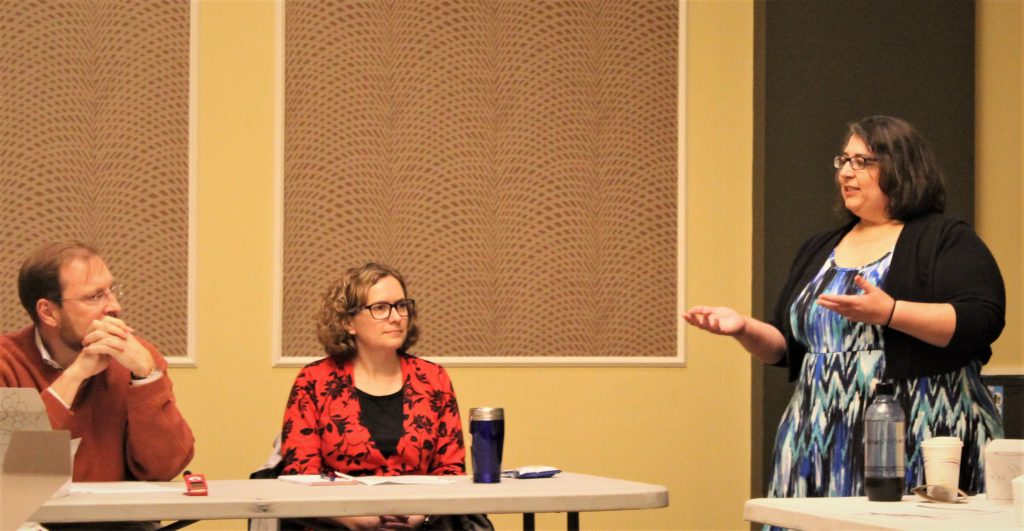Wednesday, December 17, 2014
Don Saliers and Richard Patterson
CLICK HERE FOR LINK TO PODCAST
Dr. Don Saliers (William R. Cannon Distinguished Professor of Theology and Worship, Candler School of Theology) and Dr. Richard Patterson (Philosophy) held the second CMBC Faculty Lunch Discussion of the 2014 Fall Semester, titled “Thinking Musical Thoughts.” In addressing this theme, Saliers and Patterson focused on the question of how musicians embody expressive elements of musical pieces when they perform. As they move through a piece, musicians modulate fine and gross motor movements, attending to layers of technical details as they do so. Aside from the technical component, musicians are concerned with conveying the meaning or mood of a musical composition, and this expressive quality must imbue the playing itself. How, then, do musicians transmute the expressive mood of a piece of music into the technical execution of the notes? Moreover, how do listeners decode the emotions musicians are transmitting through their playing? Saliers’ and Patterson’s discussion of the types of strategies musicians use to communicate certain moods, along with recent research findings on the universal structure underlying music, motion, and emotion, offer some insight into these questions.
As musicians themselves, Saliers and Patterson provided examples of the cognitive strategies they and other musicians use to instill their performances with an intended expressive quality. One technique musicians use is to describe verbally what they want to convey in the musical piece, whether it is an emotion, mood, attitude, idea, or ideal. For example, musicians may articulate emotional states they want to evoke like “excitement” or “mournful sadness.” Musicians keep these verbal descriptions in mind while they monitor their playing, making subtle adjustments to stay faithful to the piece’s intended mood.
A complementary strategy is to use visual imagery that captures the mood of a musical piece. Musicians will conjure visual imagery like the opening of a flower or a foggy night in a graveyard to infuse their playing with a particular emotion. Similarly, musicians use bodily metaphors to help them transmute the mood of the music into their playing. Musicians evoke bodily metaphors like heaviness/lightness, as well as varieties of dancing—elegant, courtly, comical and drunken, etc.—to play in a style consonant with these metaphors.
How exactly do these cognitive strategies allow musicians to imbue music with specific feelings? How does the visual imagery of a flower opening, for example, transmute into the tactility with which a pianist or cellist manipulates her fingers when playing a piece of music? It may have something to do with synesthesia—a neurological phenomenon in which features of distinct bodily sensations or meaningful percepts are experienced in a fashion that seems to blend the sensory modalities. For people who experience one of the most common forms of synesthesia—grapheme-color synesthesia—letters and numbers are perceived as being tinged with a particular color. It has been argued that we all experience at least a mild version of synesthesia, in that we perceive non-arbitrary mappings between different sensory percepts, in some instances. For example, many people experience non-arbitrary mappings between certain speech sounds and visual shapes. Research has found that a majority of people select an irregular star-shaped object as matching the sound “Kiki”, and a rounded blob shape as matching the sound “Bouba” (Ramachandran & Hubbard, 2001). It has been suggested that this phenomenon is an example of sound-vision synesthesia, and that people choose the “bouba” sound for the rounded object because the enunciation of the word requires the mouth to make a more rounded shape, whereas the enunciation of “kiki” requires the mouth to make more angular shapes.
Recent research suggests that there may also be non-arbitrary mappings between dimensions of music, movement, and emotions. In a study published in the Proceedings of the National Academy of Sciences, participants were asked to create either a melody or a bouncing-ball animation that expressed a specific emotion (Sievers, Polansky, Casey, & Wheatley, 2013). The participants could adjust five sliding bars to modulate the beats per minute (of the ball or the music), the predictability of the beats, smoothness (i.e. the ball could be manipulated to be smooth or spiky, and the music could be made more or less dissonant), the step size (height of the bounce/distance between notes), and the pitch of the note/angle at which the ball leans. For each emotion the participants were asked to express (angry, happy, peaceful, sad or scared), the groups chose very similar positions for the dimensions adjusted by the sliding bars, no matter if they were assigned to the melody group or the animation group. This result replicated in a group of participants from a Kreung community in Cambodia, suggesting that music and movement may be experienced as structurally similar and reflect specific emotional states across cultures. It is unclear how these non-arbitrary mappings arose, but it may be the case that humans learned to decode emotion from the movement of other people or animals; in turn, music may exploit neural systems dedicated to perceiving subtle changes in rhythm and speed to elicit emotions.
The overlapping representations of emotion, movement, and music may help explain how musicians encode expressive qualities in their works. When musicians evoke visual or bodily metaphors, these semantic representations may directly map onto specific representations in the motor cortex, allowing musicians to modify their muscle movements in alignment with the percepts activated by the metaphors. Alternatively, the pathway may be less direct, with a mental representation of a visual image or bodily metaphor evoking a distinct emotional state, which in turn maps onto a particular pattern of activation in the motor cortex. Future research promises to provide a more fine-grained account of how expressive qualities are both successfully encoded by musicians and decoded by listeners.
Throughout their discussion, Saliers and Patterson also touched on questions concerning the degree to which conscious versus unconscious processes influence musical performance. Conjuring a visual metaphor is definitively conscious in nature, but this semantic representation may influence breathing or motor movements controlled by unconscious processes, and it is unclear how these conscious and unconscious processes interact with one another. A process that contributes to musical performance may also switch from being conscious to unconscious, depending on various factors, including the length of time a musician has practiced a piece. While a musician is still learning a piece, she is consciously attending to certain muscle movements, but this conscious attention may significantly subside as she becomes more familiar with the piece such that previously conscious processes become unconscious. However, this is a fluid and dynamic process, as musicians anecdotally report bringing more automatic processes under conscious control again—for example, when they make a mistake in a performance and must correct on the fly.
Musical ‘flow states’ are a particularly rich source for questions about the relative contribution of conscious and unconscious processes, as phenomenological descriptions and research findings suggest that consciousness is altered during this state. Dr. Saliers gave a personal account akin to a flow state in which, as he commented, “the music began to play me.” Dr. Salier’s personal experience leads him to believe the state is associated with “a cessation of conscious attention” and intensification of perception. In the psychology literature on this topic, flow states are marked by effortless and complete absorption in an activity, merging of action and awareness, and a loss of reflective self-consciousness. Research on flow states among pianists found that entrance into a flow state was accompanied by a decrease in heart rate and blood pressure and a relaxation of facial muscles, perhaps explaining the effortless quality described by those experiencing a flow state (de Manzano, Theorell, Harmat, & Ullén, 2010). Researchers propose that flow states may be associated with a transient reduction of activity in the prefrontal cortex (Dietrich, 2004). Because this region is strongly involved in self-awareness and higher-level cognitive processes, reduced activity in this region during flow states accords with the phenomenological experience of diminished self-awareness and conscious attention. Because flow states are experienced as pleasant and conducive to heightened creativity, it will be interesting to see whether future research highlights strategies for more easily entering a flow state.
— Melanie Pincus
References
de Manzano, Ö., Theorell, T., Harmat, L., & Ullén, F. (2010). The psychophysiology of flow during piano playing. Emotion, 10(3), 301.
Dietrich, A. (2004). Neurocognitive mechanisms underlying the experience of flow. Consciousness and Cognition, 13(4), 746-761.
Ramachandran, V. S., & Hubbard, E. M. (2001). Synesthesia–a window into perception, thought and language. Journal of consciousness studies, 8(12), 3-34.
Sievers, B., Polansky, L., Casey, M., & Wheatley, T. (2013). Music and movement share a dynamic structure that supports universal expressions of emotion. Proceedings of the National Academy of Sciences, 110(1), 70-75.


